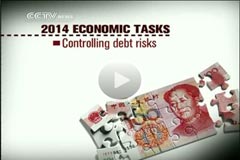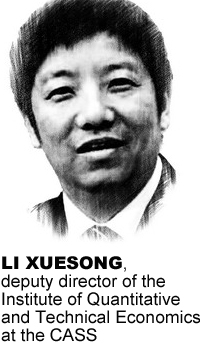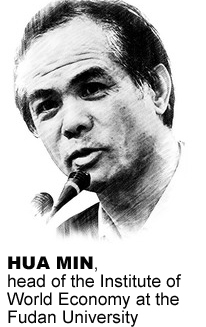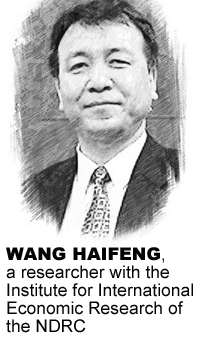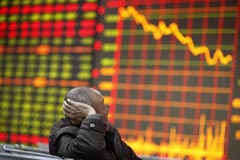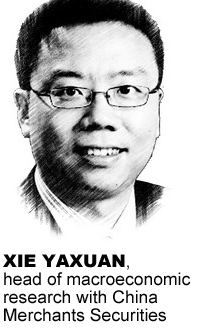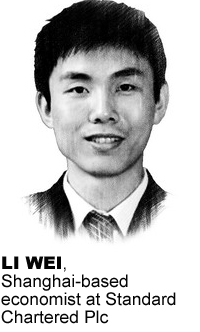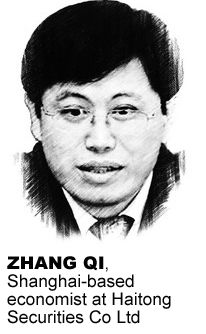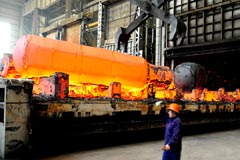|
 |
|
|
Editor's Note: Every year is an important year. But 2014 will be more important, because rarely has a recent year featured both growth and reform, or a balance of the two "irreconcilable" tasks as seen by some China watchers. Indeed, ever since the outbreak of the global crisis in 2008, China has heard a great deal more about growth than reform. But without due reform, what growth could there be? By now, China has seen it all — overcapacity in traditional heavy industry, large investment zones filled with few real companies, a glut in office space in major cities, plus some heavily indebted local governments. These hindrances will harm the country's growth and stability unless there is more reform. So, as China's experience has shown since the 1980s, reform is the only way to have good growth: by raising workers' productivity, removing bureaucratic shackles on small enterprises, knocking down monopolies by large corporations and boosting market competition. Growth and reform are never a contradiction. Doing both in the right way is precisely what China will attempt in 2014, as its leaders decided at the Third Plenum in November and the Central Economic Work Conference in December. In the process, of course, some old ways of seeking growth must end — most notably, squandering public funds on building pollutant-heavy industries. But urbanization, and the creation of intercity transportation networks, will serve as new engines for growth as well as reform. If urbanization is not a project led only by the government, and more room is created for competition in the service industries, growth will come along in the due course. There is no reason that it won't. And we can believe in the "decisive role" the market will play. China Daily interviewed 12 economists to share their observations about Chinese economy in 2014. |
|
|
China sets economic tasks for 2014 The conference has set up economic tasks for the next year and will look to ensure that issues like national food safety, and industrial restructuring get prominent attention. Next year, the country will also heavily promote the development of newly emerging industries. When it came to finances, the conference called for the control of local government debt risks and to push forward regional development. |
|
|
Q1:What do you think will be the most favorable and unfavorable domestic factors for the Chinese economy in 2014? |
|
|
China's economy is on track to start 2014 on a positive note. Since mid-2013, growth has picked up as exports recovered amid improving global demand. Domestic demand growth has held up fairly well all along, with the November data suggesting slower investment growth and faster consumption growth. The current pace and pattern of growth are setting the stage for 2014. We expect China to continue to benefit from better global demand. Domestically, the key factors are the impact of firmer monetary policy and structural reforms on growth. Weighing up the key factors, with the abovementioned demand trends broadly continuing, we expect solid growth of 8.2 percent in 2014 — which diverges from consensus projections — while being cognizant of the risks. A key question is the impact of structural reforms on growth. The "document on major issues concerning comprehensive and far-reaching reforms", released after the Third Plenum of the Party's Central Committee, is a brief to move ahead with a systematic and comprehensive program of economic and social reform. The pace of implementation is likely to be fairly gradual; we do not think that is really a problem as long as reform continues. But what about the impact on growth in 2014? We think the structural reforms that are likely to be at least partly implemented in 2014 will, on balance, be neutral or mildly positive for growth. Likely measures with a positive impact on growth include removing barriers for private capital, simplifying procedures, liberalizing and developing the financial sector and partially opening the capital account. Their impact should outweigh the effect of reforms that could dampen growth, such as charging higher State-owned enterprise dividends and channeling the revenues to the Ministry of Finance, property taxation, higher prices and/or taxes for raw resources and a change in the weighting in the performance evaluation of senior local government officials. Policymakers are implementing a firmer monetary stance in order to rein in credit growth and financial risks. The firmer stance is evidenced by the deceleration of financial aggregates and higher interest rates on the interbank market. Even as policymakers tighten up on banks' use of interbank financing and "shadow banking", we expect they will aim to maintain solid expansion of core bank lending, including by possibly easing up on banks' lending quotas. Such a pattern should limit the impact of tighter monetary policy on economic growth, as in 2011, when the government clamped down on "shadow banking" without causing an obvious economic slowdown. But a larger negative surprise would likely lead the government to compromise on the firmer policy stance. We see two main sources of risks to our growth outlook for 2014. Weaker global demand would mean lower export growth and corporate investment. Domestically, the impact of a tighter monetary stance on growth could be larger than we expect. Also, amid changes in monetary policy conduct, hiccups and unexpected outcomes are possible. |
|
|
The Chinese economy will remain in a period of important strategic opportunities in 2014. As stable economic progress is expected to continue, GDP growth of 7.5 percent is possible in 2014, which will remain in a reasonable range. A key theme of next year's economic development is that the central government will focus on deepening reform and opening-up and further pursue structural rebalancing and industrial upgrading following the directives of the Third Plenum of the 18th Central Committee of the Communist Party of China. Positive factors to support growth momentum are increasing. One of the most important is that China's urbanization is entering a new stage of rapid development. With the stimulus of reform, urbanization is expected to accelerate in 2014. Many rural migrant workers may start new lives in cities as "the new citizens" — they can enjoy urban residents' social insurance, education and employment opportunities. The changes in their status will expand the consumer market. The services industry will be boosted at a faster pace — a scenario that policymakers hope to see during the growth pattern transaction. In 2014, demand for financial, education and healthcare services will expand faster. Online shopping will continue to grow rapidly. The increase of domestic consumption may partly offset slower fixed-asset investment and help keep stable overall economic growth. One of the downside risks of concern for next year is that industry will face more difficulties. The official figures show that in the third quarter of this year, industrial companies' revenue and profit improved, compared with the first half. But rising production costs, declining wholesale prices and tight credit are holding them back. As these difficulties may further weaken business confidence, they may prefer to cut output and investment. Also, the government has decided to keep credit growth "at a reasonable pace" prevent financial risks. Thus, a relatively tight financial environment is likely in 2014, which may slow industrial investment. |
|
|
Official warns on export outlook There's little cause for optimism about China's exports in 2014, because demand in both developed and developing countries is growing too slowly to boost purchases of the nation's products, a commerce official told China Daily. Meanwhile, rising domestic costs are eroding China's traditional competitive advantage in prices, forcing the government to "fight hard for steady trade growth" in the coming year. |
|
|
Q2: What do you think will be the favorable and unfavorable international factors for the Chinese economy in 2014? |
|
|
In China, the ongoing reforms will broaden and deepen in 2014. Consequently, favorable international forces for the Chinese economy are those that support these reforms, and vice versa. In the United States, the gradual tapering of the (quantitative easing program) will strengthen the US recovery, thus supporting Chinese direct and portfolio investments in the US. Similarly, deleveraging will not erode American consumption. In turn, an unanticipated warming of US-China relations could contribute to significant broadening and deepening of the bilateral Strategic & Economic Dialogue. In Europe, a new consensus on the need for structural reforms and gradual improvement of economic prospects would support Chinese trade and investment in the region, while promoting European investment in China. In East Asia, a warming of China-Japan relations would have positive effects on bilateral economic relations. In the South China Sea, gradual insulation of political friction would have the potential to strengthen China-ASEAN relations. It could also boost significant developments toward the "maritime Silk Road," deeper regional integration and China's participation in vital trade blocs. Successful international management of the Middle East's multiple friction points would increase regional energy supply. Global growth would rebound on policy actions in advanced economies, thus boosting demand for Chinese exports, direct and portfolio investments worldwide, while supporting foreign trade and multinational investments in China. In the US, the tapering of the QE program could start too early (or too late) thus causing significant market volatility and economic uncertainty. Further, Washington's bipartisan budget deal could unravel, which would cause market volatility and economic stagnation. There could be an unexpected chill in US-China relations, which would lead to questions about the long-term fate of Chinese-owned US Treasuries, Chinese investment in the US and China's dollar-denominated assets. Instead of progress, the European sovereign crisis could take an adverse turn, which would endanger Chinese trade and investment in the region, as well as European investment in China. It could also contribute to EU-China friction and conflict in trade, particularly high-tech trade. There could be a disruptive deterioration in China-Japan relations with substantial negative feedback effect on bilateral economic relations. An unforeseen clash could occur in the South China Sea, which would cause bilateral or, even worse, multilateral conflicts with Japan, the Philippines, Vietnam and the US. It could endanger regional integration and Chinese participation in critical trade blocs. Renewed conflicts in the Middle East could endanger energy supply that is vital to China's continued industrialization and urbanization. Finally, there could be significant erosion in global growth prospects, due to deepening stagnation in advanced economies, slowing growth in emerging economies, or both. |
|
|
Under an international context, the Chinese economy faces mostly adverse factors in 2014. The major threat is the tapering of the US Federal Reserve's quantitative easing program, anticipation of which has already spurred currency slumps and interest rate increases. The global economy is rebounding on a steady course, based on forecasts by the International Monetary Fund and several leading rating agencies. The relatively quick rebound, as opposed to the financial crisis back in the 1930s, can be attributable to the interdependent trade networks. Organic trade development has boosted the global recovery after the economic downturn. Developed countries are getting out of their economic nadir and robust signs of recovery are being widely seen, notably in the United States. As a result, the country is due to scale back its $85 billion a month program of asset purchases. Theoretically, a badly executed pullback may derail the Chinese economy in the sense that a reduction in liquidity will raise interest rates and slow credit growth and investment. Besides, concerns that tighter policies may weaken growth are likely to temper hiring and dampen consumption. However, it is also high time we delve into the reasons why China is especially vulnerable to the US loosening measures, and rethink China's monetary policy that has been implemented since the outset of 2009. Mature markets are expected to grow at a pace of 2 percent year-on-year starting from 2014. For instance, the US has stimulated its real economy following US President Barack Obama's call to reinvigorate the manufacturing sector. In contrast, the expansion of developing economies may shrink to just 1.43 percent. Years of quantitative easing in the US and Europe have yet to feed inflation, because such loosening policies were well accompanied by expansionary fiscal policies, featuring an increase in government purchases and cuts in taxes, so that a majority of flowing capitals were properly guided into the real economy. If you read carefully into foreign capital flows, the majority of capital inflows into industrial economies are long-term investments, while emerging markets, notably China, show the opposite pattern. Multinational corporations are gradually relocating from China back to either their home countries or even-lower cost nations. On the contrary, the country has constantly seen fresh speculative inflows of money in the past two years. The country's foreign-exchange reserves expanded at an unprecedented pace, despite a dramatic contraction in its export figures. These seemingly controversial stats suggest that the foreign-exchange reserve expansion can only result from the influx of ‘hot money' instead of long-term, more committed investment. This should be blamed on the wrong monetary policies adopted by governments of almost every emerging market, including that of China. We should lower, rather than raise, interest rates to tame liquidity. With higher rates, funds will come to China and leverage the visible rate gap, fueling real estate bubbles and credit growth. These factors cannot be phased out in 2014, which will greatly overshadow the Chinese economy. |
|
|
The United States Federal Reserve Board's announcement that it will scale back its bond-buying program could crimp liquidity in China at a delicate moment, analysts warned. China's interbank lending rate is at its highest since June, when the central bank pushed up rates to discourage borrowing, a move engineered partially to prevent further shadow banking activity, said Patrick Chovanec, managing director of Silvercrest Asset Management Group and former economics professor at Tsinghua University. |
|
|
Q3: How will China's economic slowdown affect foreign enterprises' investment in the nation, and how can they adapt to that change? How will the slowdown affect the global economy? |
|
|
While we expect China's economic growth to slow to 7 to 8 percent next year and then further to 6 to 7 percent in the following five years, we want to highlight the positives of the slowdown. First, the absolute increment in China's GDP will still be more than $900 billion a year (assuming an average 3 to 3.5 percent inflation rate). That amount will be bigger than 10 years ago, when China's nominal GDP was growing at 17 to 18 percent a year. China's contribution to global GDP growth will still likely be the largest in the world. Second, slower but more balanced and sustainable growth that is less reliant on investment is also a positive for the world economy. For the global economy, the impact of China's slowdown depends on the cause of the slowdown. If it is due to a weak global economy and weak exports, the impact will be less. If the slowdown is caused by slower domestic demand, especially investment demand, then the impact on some countries will be much more noticeable. Slower growth of investment in China means weaker demand for commodities and materials, as well as investment goods. So the countries that will be affected most will be the commodity-exporting countries, particularly metals and coal exporters. However, China's demand for consumer goods and services will likely continue to grow strongly, benefiting countries that are exporters of such goods and services. China will also likely go through some structural shifts in its exports. As the country becomes less competitive in lower-end, labor-intensive products and moves up the value chain in exports, there will be increased opportunities for low-cost countries such as Vietnam, Bangladesh and Pakistan. Meanwhile, China may start to compete more with countries that export middle-range products. For foreign companies investing in China, there may be a gradual shift away from investing in labor-intensive export sectors. Meanwhile, China's domestic market will be expanding at a still-fast pace, rising by more than $900 billion a year, which offers great investment opportunities. Therefore, we foresee foreign investment in China will increasingly focus on goods and services that satisfy China's own needs. A good example is a recent announcement by Daimler Co Ltd, the German automaker, which said it will locate the company's first and only engine factory outside of Germany in China. Foreign companies can no longer expect China's demand for materials and commodities to grow at the previous fast pace. Also, they should see the Chinese market itself as the main reason for investment in China, not exports. In the Chinese market, foreign companies may face tougher competition as they may not have the comparative advantage they enjoyed in international markets relative to Chinese companies. Foreign companies need to do research on China's local market, which is big and diverse, as well as being very different from the international markets they are familiar with. Foreign companies will also need to rely more on domestic talent in China to help them to expand in the local markets. |
|
|
The growth potential in China's traditional industries and labor-intensive industries, I believe, is quite limited now. However, foreign investors can still find lots of opportunity in the high-tech sector and in the service industries, such as healthcare, education, culture and legal services. Though China's economic growth may slow in the coming years, it will remain one of the most attractive destinations for foreign investors, as the downside risks in other emerging economies are much higher. Though the government hasn't set a specific economic growth target for 2014, most economists agree on growth of about 7 percent. The economic slowdown is actually not a bad thing. It enables the government to address some thorny problems. The reform package revealed after the Third Plenum of the Communist Party of China's 18th Central Committee clearly shows that the government is keen to advance market-based reforms to achieve quality growth. Moreover, slower but steady growth in China means more for the global economy, compared with volatile growth The ballooning bubble in the real estate sector and the growing uncertainties surrounding local government debt are the two major challenges facing China's economy. If big problems occur in these two sectors, it will hurt developed economies' confidence in China. But so far, the chance of that happening remains low. |
|
|
GDP growth seen slowing to 7.3% in 2014 China's economic growth is likely to slow to 7.3 percent in 2014 amid the leadership's ongoing moves to restructure the world's second-largest economy, experts said on Tuesday. "The Chinese economy has stabilized and we have edged up our GDP growth estimate to 7.7 percent this year. We forecast a slowdown to 7.3 percent in 2014, followed by a further slowdown to 5.9 percent in 2018," said Xu Sitao, chief representative of The Economist Group in China, citing a report from the group. |
|
|
Q4: What contributions would investment, consumption and net export make to the Chinese economy in 2014? Do you see a change in the economic structure from this year? What would be the reason for such a change? |
|
|
China's economy is in the midst of a fundamental transition. This transition involves moving from investment to consumption, from exports to imports, and more provision of social services such as health and pensions by the government. This transition is one of the key global economic trends over the next decade and, because China is so large, it has implications for all countries. Over the past five years, investment has caused more than half of China's growth: For the period of 2009 to 2013, the Economist Intelligence Unit estimates that investment accounted for an average of 5.1 percentage points of growth every year, as compared with 3.2 percent for consumption, 1.2 percent for government expenditure and -0.7 percent for foreign trade. In 2014, investment will still be the largest source of growth, but it is getting smaller. Our prediction is that investment will add 3.2 percent to economic growth in 2014, as compared with 3.7 percent in 2013. This amount will get lower every year, and be down to 2.3 percent by 2018. We think that 2016 will be the year that private consumption starts to make a larger contribution to growth than investment. The share of investment in China's growth has been very large by international standards, and it is not unusual that it should fall. Indeed, there are some benefits to a greater role for consumption. The major benefit is that higher levels of consumption will mean that Chinese people can enjoy more of the benefits of economic growth. The two are, of course, linked. One big driver of higher consumption is rising wages. But rising wages make the cost of doing business higher, and so reduce investment. Investment is also being affected by the relatively slow pace of economic reform in recent years. Another big element of China's transition is from exports to imports. Many of those imports will become part of private consumption. The Chinese government's commitment to steering the country's economy onto a slower, more sustainable growth path has raised concerns among many of the firms and countries that have come to rely on China's surging demand for imports. The pattern of Chinese demand is certainly set to shift over the next five years, but the pace of the change is likely to be slower than some expect, and the country's imports will continue to rise rapidly. China will buy more from countries that produce consumer goods, such as the US, and less from countries that produce the types of raw materials used in investment, such as Australia. Fears that a slowdown in China's economy will lead to a slump in export growth in other economies are broadly misplaced. Although the countries that have benefited most from China's construction boom have the most to be concerned about, they should have several years to adjust to slowing levels of Chinese investment. For others, the prospects offered by the Chinese market remain bright. |
|
|
Exports will play a bigger role in driving China's growth next year. We estimate that domestic consumption and investment will remain at a similar level next year compared with that of this year. But the strong external demand resulting from a recovering United States and Europe will help fuel the GDP growth of the world's second-largest economy by an extra 0.3 percentage points. Our predictions show that China's GDP growth will bounce back to 7.9 percent in 2014 from a valley of 7.6 percent, which is likely to be the case for this year. All this acceleration will come from the improving external demand. With the uptick in global demand, China's export growth will speed up to 10 percent from a depressing 7 percent predicted for this year. The extra growth will mainly be a result of the recovery in the US economy, which, it is hoped, will accelerate from 2.6 percent from 1.6 percent this year. The trend of US economic growth is highly consistent with China's export growth, although China's largest export destination is Europe rather than the US. This is because a large proportion of China's exports heading to Southeast Asian countries comprises semi-finished goods, which eventually go to North America as finished products. China's exports also will benefit from a better European economy that also will see a slight recovery in 2014 from the recession of this year. The European economy is likely to see 1 percent growth next year instead of the 0.3 percent retrogression it saw in 2013. Despite a strong external demand, China's domestic demand will remain sluggish next year. The country's average national income is still relatively low and has many structural problems. The measures introduced by the Chinese government to boost domestic consumption will not change the fundamental issue, and the average low purchasing power of the Chinese people is likely to persist for quite a while. As for investment, there is both good news and bad news. The recent Third Plenum called for measures to allow more private capital in traditionally restricted areas such as infrastructure. This will create more channels for private investment and also stimulate overall investment growth. But at the same time, the Central Economic Working Conference reiterated the importance of regulating local government's debt scale, implying that stricter measures will be released next year, which will dampen the amount of investment initiated by local governments. Considering both factors, investment will remain at a level similar to this year's. |
|
|
China's growth to help markets next year A majority of global investment professionals have strong confidence that China's stable economic progress in 2014 will be a positive force for global growth, an international survey showed on Monday. According to the 2014 Global Market Sentiment Survey conducted by the CFA Institute, an international association of investment professionals, 71 percent of the 6,561 respondents around the world believe that the sound development of China's economy next year will benefit their own economy's growth. |
|
| Q5: How do you evaluate the risks of local government debt in China? What measures would you propose to help prevent and resolve such risks? | |
|
The potential for the development of a local government debt market in China is looking increasingly likely, given reforms announced by the central government over 2013. While local governments are largely responsible for building China's infrastructure, their financing options are limited. The local governments' own source of revenues and central government grants are insufficient, and aside from a small pilot bond program, they are prohibited by law from borrowing directly or guaranteeing other entities. As a result, local governments borrow indirectly through local government financing vehicles (LGFV) and other government-related entities. Such debt is not consolidated in their financial reporting, and, therefore, its amount and terms are not transparent. A more direct local government borrowing model, such as we see in many other countries, would seem to offer a better financing alternative. But some basic conditions underlie all successful markets, and they include: 1) a strong institutional framework with clearly defined revenue and expenditure responsibilities, and sufficient resources to fund expenditures; 2) detailed and transparent financial, debt and governance information; 3) clear accountability for debt obligations and repayment responsibilities; and 4) well-developed bureaucracies and administrative practices. The central government over the past 18 months has made announcements that focus on all of these key features. These culminated in the Third Plenary statements in November. Subsequently, during the Dec 12-15 National Economic Summit, the central government stated that one of its key priorities for 2014 is "laying the foundation" for a better control of local government- related debt. We expect to see a greater divergence between LGFVs in credit quality. Some small and marginal LGFVs will likely face a higher probability of default because of a falling level of government support — as the government's position on this issue becomes clearer — and the fact that their stand-alone profiles are intrinsically weak. But the scale of defaults will likely be restrained, and government support remains for LGFVs involved in projects important to local economic development and infrastructure. |
|
|
I believe local government debt will not continue its current reckless expansion over the next few years. There are three reasons for this. First, "containing local government debt risk" has been identified as one of the six major tasks for next year's economic work by the just concluded Central Economic Work Conference. This reflects a wide recognition of the seriousness of the problem among top leaders. Second, the Organization Department of the Communist Party of China, which oversees personnel affairs within the Party, announced recently it would put "the debt raised within a local official's term" as criteria for deciding his or her career advancement. This would serve as a way to curb local government debt pileup at the root cause. Third, huge local government borrowing has already squeezed out other parts of the economy, and current economic conditions can no longer support this scale of borrowing. The previous model, in which local government revenues relied heavily on land sales, has run its course. As property price increases in third- and fourth-tier cities lose momentum, many local government financing vehicles (LGFVs) can't repay debts from land sale revenue anymore. What's more, the obligation to repay debts has squeezed local governments' disposable public finance resources, and as more LGFVs borrow, interest rates pick up, adding more costs to their financing. To dissolve the risks from local government debts, it is essential to change the opaqueness of current local government financing. The document following the Third Plenum has promised to compile local government balance sheets. That is a good direction. The Central Economic Work Conference has said that the different kinds of debts will be categorized and put under broad budget management. Optimally, this means that local governments' borrowing would be scrutinized by local legislatures, and oversight can be improved. There is a major difference between China's local debts and those in Western countries. Here, they are mainly used in productive projects and could be transferred into properties. So projects that enjoy stable cash flow and expect future returns could be financed by municipal bond issuing. Some projects that may reap very little revenue from the projects themselves but have large externality, such as farmland and water conservancies, could be backed by fiscal revenue. Another type of project could invite the private sector to participate. Along with these, a small portion of existing non-performing loans could be dealt with by local asset management corporations. |
|
|
Chinese leaders have pledged to tackle the problem of local governments' debts next year and create a stable economic and social environment to promote reforms, according to the statement issued by the Central Economic Work Conference that ended on Friday. This is the first time "controlling and addressing local government debt risks" has been made as an especially important task in economic work. |
|
|
Q6: What do you expect for China's industrial development in 2014? How to address the overcapacity in the traditional industrial sectors? How to grasp the opportunities created by new technology? |
|
|
New technology should play a part in resolving the overcapacity issue. Most of the idle capacity is for low-end products, good quality products are never hard to sell. The ideal way out of the issue would be to upgrade idle capacity through innovation and find market demand. But innovation doesn't happen overnight, it happens over time through improved education and innovation systems. In the short run, industrial consolidation will help to erase some of the idle capacity. However, consolidation can't be driven by administrative measures; it should result from decisions made by the companies in chase of profitability. Past experience has proven that overcapacity can't be solved through government planning. For instance, steel mills often pretend to shutter unnecessary production only to restart it later, while others have been secretly adding new capacity as local governments choose to look the other way out of concern for job creation and revenue. Bad loans and unemployment will be the two major issues if factories are closed. But that shouldn't be the reason not to proceed with it. Workers who lose their jobs should be covered by social security. And it is good to see that Beijing has been releasing measures to mend the nation's social security network. The problem of bad loans is more complicated. It's associated with local government borrowing and the banking sector. If too many projects are shut down, local governments might default and banks might suffer losses, which may translate into financial turmoil and dampen already slowing growth. Local governments have huge debts, which they amortize by rezoning and selling land. Already squeezed by exorbitant property prices and popular resistance to land takings, they now face higher interest rates and property taxes. But that's not the reason to not follow through with cutting overcapacity. The government should handle the problem with a set of reforms and target the root of the problem, rather than through administrative measures that focus on short-term benefits. In 2014, the issue of overcapacity will slightly improve, but won't be cured. |
|
|
Industrial overcapacity is a chronic problem in China. It's widespread and affects multiple industries. Most of the industries in question face absolute overcapacity, instead of structural. And the problem is worsening as there are still many projects in construction. The steel, shipping, cement electrolytic aluminum and sheet glass sectors are among the worst-hit industries. It's widely believed that about 20 percent of all of the country's urban and rural jobs are in those five industries. After the recent annual Central Economic Work Conference, a statement stressed the downward pressures on domestic economic growth, one being the serious overcapacity in some industries. There are no updated official figures on how bad the problem is, so no one knows exactly how much of the capacity should be cut off. We need reliable data before the government can tailor an accurate strategy to solve the problem. The local governments had an incentive to foster industry growth and that partly caused the problem. The governments gave companies subsidies, discounts on land and tax perks to encourage them to set up plants in their jurisdictions and push up GDP figures. Economic fluctuation is another reason. Before the financial crisis hit, growth was in high gear. Companies were generous when making new investments and the government was more than willing to let them do that. Many of the capacity went idle after the financial crisis depressed demand. In their battle to solve the overcapacity issue, regional governments lack a proper strategy. The problem can't be solved by strengthening the administrative approval process. Overcapacity is not unusual in a market economy, but a sound market system will solve the problem over time through adjusted prices and investment returns. In China, the problem of overcapacity is to a great extent a result of government interference, so market-oriented reforms are essential to solve the problem. At the center is the interest rate reform, which will reveal true funding costs and make investment in industries with overcapacity expensive. Of course, that should be supplemented by a basket of other reforms, centered on changing local governments' incentives. Overall, the cure for the problem lies with the invisible hand, rather than the visible hand. |
|
|
Link overcapacity with performance A think tank has suggested that the removal of industrial production overcapacity be used as one of the key criteria to evaluate local government officials' performance as the country steps up efforts to address the lingering problem. It is much more urgent now than in previous years to solve the overcapacity problem. Big efforts should be made to close some inefficient production lines, even risking rising unemployment, said experts at a forum of the China Center for International Economic Exchanges. |
